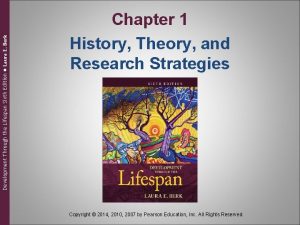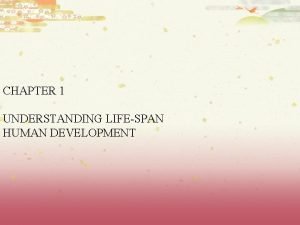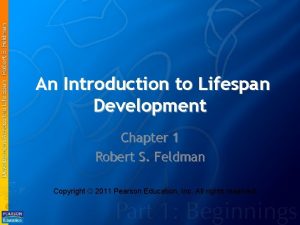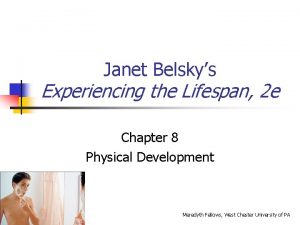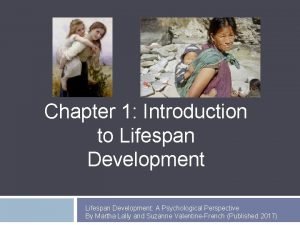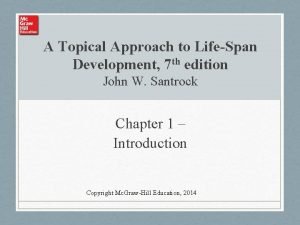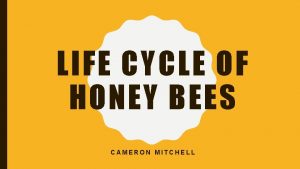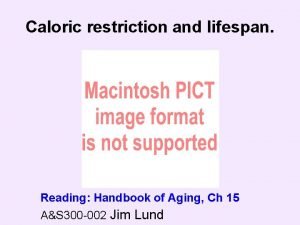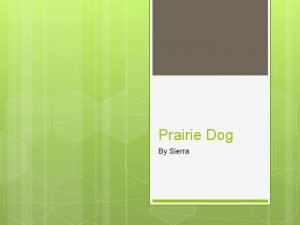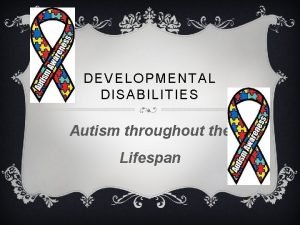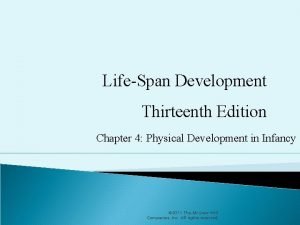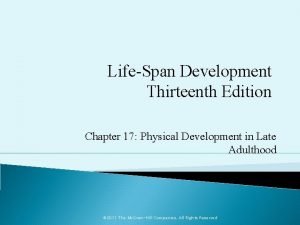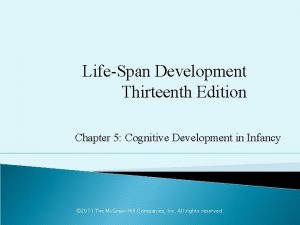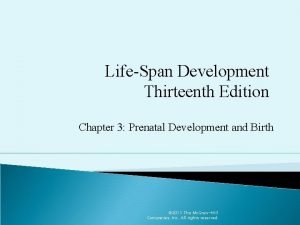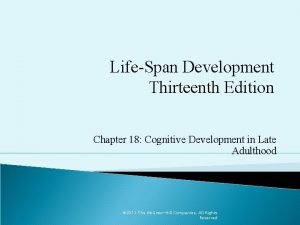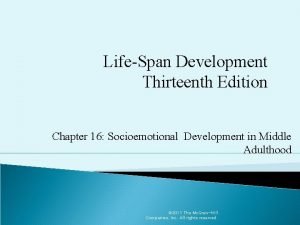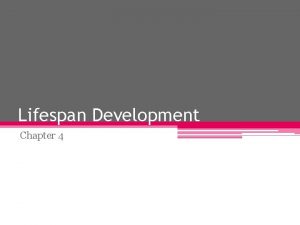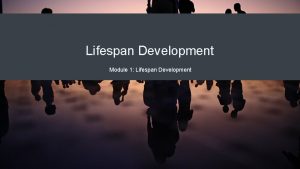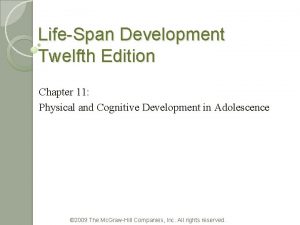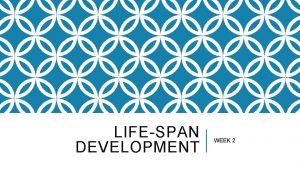LifeSpan Development Thirteenth Edition Chapter 13 Physical and























- Slides: 23

Life-Span Development Thirteenth Edition Chapter 13: Physical and Cognitive Development in Early Adulthood © 2011 The Mc. Graw-Hill Companies, Inc. All Rights Reserved

The Transition From Adolescence to Adulthood § Becoming an Adult § Emerging Adulthood: the transition from adolescence to adulthood § Occurs from approximately 18 to 25 years of age § Key Features § Identity exploration, especially in love and work § Instability, self-focused, and feeling in-between § The age of possibilities, a time when individuals have an opportunity to transform their lives © 2011 The Mc. Graw-Hill Companies, Inc. All rights reserved. 2

The Transition From Adolescence to Adulthood § Becoming an Adult § Markers of Becoming an Adult: § Holding a full-time job § Economic independence § Taking responsibility for oneself © 2011 The Mc. Graw-Hill Companies, Inc. All rights reserved. 3

The Transition From Adolescence to Adulthood § Becoming an Adult § The Transition from High School to College § Top-dog phenomenon § Movement to a larger school structure § Increased focus on achievement and assessment § Several positive features © 2011 The Mc. Graw-Hill Companies, Inc. All rights reserved. 4

Physical Development § Physical Performance and Development: § Peak physical performance typically occurs between 19 and 26 § Muscle tone and strength usually begin to show signs of decline around age 30 © 2011 The Mc. Graw-Hill Companies, Inc. All rights reserved. 5

Physical Development § Health: § Emerging adults have twice the mortality rate of adolescents § Few chronic health problems § Increase in bad health habits § Positive health behavior equals positive life satisfaction © 2011 The Mc. Graw-Hill Companies, Inc. All rights reserved. 6

Physical Development § Eating and Weight § Obesity: § Prevalence of obesity in U. S. adults is increasing § Factors Involved in Obesity § Heredity § Leptin: a protein involved in feeling full § Set point § Environmental factor © 2011 The Mc. Graw-Hill Companies, Inc. All rights reserved. 7

Physical Development § Regular Exercise: § Helps prevent diseases § Aerobic exercise: sustained exercise that stimulates heart and lung activity § Exercise benefits both physical and mental health § Improves self-concept and reduces anxiety and depression © 2011 The Mc. Graw-Hill Companies, Inc. All rights reserved. 8

Physical Development § Substance Abuse § Alcohol: § Binge drinking: § Increases in college § Alcoholism: a disorder that involves long-term, repeated, uncontrolled, compulsive, and excessive use of alcoholic beverages and that impairs the drinker’s health and social relationships § Environmental and genetic factors play a role © 2011 The Mc. Graw-Hill Companies, Inc. All rights reserved. 9

Physical Development § Substance Abuse § Cigarette Smoking and Nicotine § Smoking linked to 30% of cancer deaths, 21% of heart disease deaths, and 82% of chronic pulmonary disease deaths § Fewer people smoke today than in the past § 50 million Americans still smoke today © 2011 The Mc. Graw-Hill Companies, Inc. All rights reserved. 10

Sexuality § Sexual Activity in Emerging Adulthood § Patterns of Heterosexual Behavior include: § Males have more casual sex partners, while females report being more selective § 60% have had sexual intercourse with only 1 individual in the last year § 25% report having sexual intercourse only a couple of times a year or not at all § Casual sex is more common in emerging adulthood than in young adulthood © 2011 The Mc. Graw-Hill Companies, Inc. All rights reserved. 11

Sexuality § Sexual Orientation and Behavior § Heterosexual Attitudes and Behavior § Americans tend to fall into three categories: § 1/3 have sex twice a week or more, 1/3 a few times a month, and 1/3 a few times a year or not at all § Married (and cohabiting) couples have sex more often than noncohabiting couples § Most Americans do not engage in kinky sexual acts § Adultery is the exception rather than the rule § Men think about sex far more often than women do © 2011 The Mc. Graw-Hill Companies, Inc. All rights reserved. 12

Sexuality § Sexual Orientation and Behavior § Sources of Sexual Orientation § Sexual orientation is a continuum from exclusive male–female relations to exclusive same-sex relations § Most likely a combination of genetic, hormonal, cognitive, and environmental factors © 2011 The Mc. Graw-Hill Companies, Inc. All rights reserved. 13

Sexuality § Sexual Orientation and Behavior § Attitudes and Behaviors of Lesbians and Gay Males § Many gender differences that appear in heterosexual relationships occur in same-sex relationships § Lesbians have fewer sexual partners and less permissive attitudes about casual sex than gay men § Hate crimes and stigma-related experiences are a special concern © 2011 The Mc. Graw-Hill Companies, Inc. All rights reserved. 14

Sexuality § Sexually Transmitted Infections (STIs): diseases contracted primarily through sex § Affect about 1 of every 6 U. S. adults § HIV/AIDS has had the biggest impact on sexual behavior in the last several decades § HIV leads to AIDS (acquired immune deficiency syndrome) © 2011 The Mc. Graw-Hill Companies, Inc. All rights reserved. 15

Sexually Transmitted Infections Sexuality © 2011 The Mc. Graw-Hill Companies, Inc. All rights reserved. 16

Sexuality § Forcible Sexual Behavior § Rape: forcible sexual intercourse without consent § Most victims are women and are often reluctant to report the incident, although rape of men does occur § Males in the U. S. are socialized to be sexually aggressive, to regard women as inferior, and to view their own pleasure as most important § Date or acquaintance rape is an increasing concern today § Sexual harassment: a manifestation of power of one person over another § Takes many forms © 2011 The Mc. Graw-Hill Companies, Inc. All rights reserved. 17

Cognitive Development § Cognitive Stages § Piaget’s View: § Adolescents and adults think qualitatively in the same way (formal operational stage) § Young adults are more quantitatively advanced because they have more knowledge than adolescents § Some developmentalists theorize that individuals consolidate their formal operational thinking during adulthood § Many adults do not think in formal operational ways at all © 2011 The Mc. Graw-Hill Companies, Inc. All rights reserved. 18

Cognitive Development § Cognitive Stages § Realistic and Pragmatic Thinking: § As adults face the constraints of reality, their idealism decreases § Reflective and Relativistic Thinking: § Adults think in favor of reflective, relativistic ways § Is there a fifth, postformal stage? § Postformal thought § More reflective judgment, solutions to problems can vary, emotions can play a role in thinking © 2011 The Mc. Graw-Hill Companies, Inc. All rights reserved. 19

Cognitive Development § Creativity seems to peak in the 40 s and then decline slightly § Extensive individual variation in the lifetime output of creative individuals © 2011 The Mc. Graw-Hill Companies, Inc. All rights reserved. 20

Careers and Work § Developmental Changes § From mid-twenties on, individuals often seek to establish their emerging career in a particular field § Finding a Path to a Purpose § Only 20% of 12 – 22 -year-olds had a clear vision of where they want to go in life © 2011 The Mc. Graw-Hill Companies, Inc. All rights reserved. 21

Careers and Work § Monitoring the Occupational Outlook § Be knowledgeable about different fields and companies § The Impact of Work § Most spend 1/3 of their lives at work § Important consideration is how stressful the work is § Work During College § 81% of part-time U. S. college students are employed © 2011 The Mc. Graw-Hill Companies, Inc. All rights reserved. 22

Careers and Work § The Impact of Work § Unemployment produces stress and is related to physical problems, mental problems, marital difficulties, and homicide § Dual-Earner Couples: § Sometimes difficult to find a balance between work and the rest of life § Diversity in the Workplace § Women have increasingly entered the labor force © 2011 The Mc. Graw-Hill Companies, Inc. All rights reserved. 23
 Development through the lifespan 6th edition
Development through the lifespan 6th edition Lifespan development third edition
Lifespan development third edition Lifespan development third edition
Lifespan development third edition Openstax
Openstax Development takes place gradually
Development takes place gradually Exploring lifespan development chapter 1
Exploring lifespan development chapter 1 Exploring lifespan development chapter 1
Exploring lifespan development chapter 1 Nn teens
Nn teens Ul guidance counselling
Ul guidance counselling Discontinuous development psychology
Discontinuous development psychology A topical approach to lifespan development
A topical approach to lifespan development Using mis 10th edition
Using mis 10th edition Chapter 1
Chapter 1 Snow leopard predators
Snow leopard predators Gulper eel facts
Gulper eel facts Life span of fruit to be used in a caramel petit fours
Life span of fruit to be used in a caramel petit fours Splendour beetle
Splendour beetle Honey bee lifespan
Honey bee lifespan Ponce de leon nationality
Ponce de leon nationality Henry hudson 2nd voyage
Henry hudson 2nd voyage Lifespan of every animal
Lifespan of every animal The developing person through the lifespan
The developing person through the lifespan Prairie dog lifespan
Prairie dog lifespan Autism lifespan
Autism lifespan
